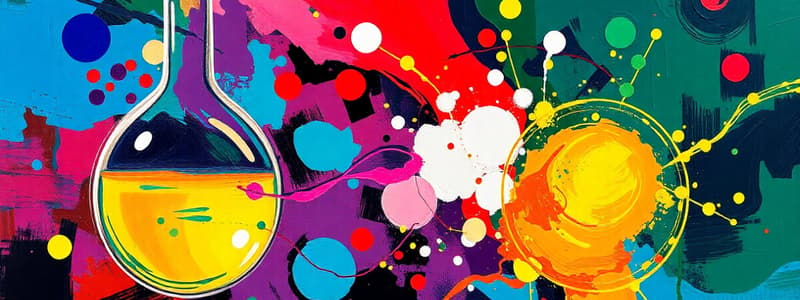Podcast
Questions and Answers
Which of the following best describes the relationship between a solute and a solvent?
Which of the following best describes the relationship between a solute and a solvent?
- The solvent dissolves the solute to form a solution. (correct)
- The solute and solvent react chemically to form a precipitate.
- The solute dissolves the solvent to form a solution.
- The solvent and solute are immiscible, creating a suspension.
What is the term for a solution that contains more dissolved solute than it can normally hold at a given temperature?
What is the term for a solution that contains more dissolved solute than it can normally hold at a given temperature?
- Unsaturated solution
- Supersaturated solution (correct)
- Saturated solution
- Diluted solution
Which of the following factors would NOT affect the solubility of a solid solute in a liquid solvent?
Which of the following factors would NOT affect the solubility of a solid solute in a liquid solvent?
- Stirring the solution
- Pressure applied to the solution (correct)
- Temperature of the solvent
- Nature of the solute and solvent
What distinguishes miscible liquids from immiscible liquids?
What distinguishes miscible liquids from immiscible liquids?
An alloy is a mixture of metals. What is an amalgam?
An alloy is a mixture of metals. What is an amalgam?
Which of the following describes the process of dilution?
Which of the following describes the process of dilution?
If you have $500 \text{ mL}$ of a $0.2 \text{ M}$ solution, and you dilute it to $1 \text{ L}$, what is the new concentration?
If you have $500 \text{ mL}$ of a $0.2 \text{ M}$ solution, and you dilute it to $1 \text{ L}$, what is the new concentration?
How do isotopes of the same element differ?
How do isotopes of the same element differ?
What is the relationship between molar volume and diffusion?
What is the relationship between molar volume and diffusion?
Which statement correctly differentiates between cations and anions?
Which statement correctly differentiates between cations and anions?
Flashcards
Solution
Solution
A homogeneous mixture of two or more substances.
Solute
Solute
The substance that is dissolved in a solution.
Solvent
Solvent
The substance that dissolves the solute in a solution.
Solubility
Solubility
Signup and view all the flashcards
Dynamic Equilibrium
Dynamic Equilibrium
Signup and view all the flashcards
Miscible
Miscible
Signup and view all the flashcards
Immiscible
Immiscible
Signup and view all the flashcards
Amalgam
Amalgam
Signup and view all the flashcards
Alloys
Alloys
Signup and view all the flashcards
Unsaturated Solution
Unsaturated Solution
Signup and view all the flashcards
Study Notes
- Solution: A homogenous mixture of two or more substances.
- Solute: The substance that dissolves in a solvent.
- Solvent: The substance that dissolves a solute.
- Solubility: The maximum amount of solute that can dissolve in a given amount of solvent at a specific temperature.
- Dynamic Equilibrium: A state where the rate of dissolving equals the rate of precipitation, resulting in no net change in solute concentration.
- Miscible: Liquids that can dissolve in each other in any proportion.
- Immiscible: Liquids that do not dissolve in each other.
- Amalgam: An alloy of mercury with another metal(s).
- Alloys: A mixture of two or more metals, or a metal with one or more non-metals.
- Unsaturated Solution: A solution that contains less solute than the maximum amount it can dissolve..
- Saturated Solution: A solution that contains the maximum amount of solute that can dissolve.
- Dilution: The process of reducing the concentration of a solution by adding more solvent.
- Supersaturated Solution: A solution that contains more solute than the maximum amount it can dissolve, achieved through specific conditions.
- Molar Concentration: The amount of a substance in a defined space.
- Electrons: Negatively charged subatomic particles that orbit the nucleus of an atom.
- Protons: Positively charged subatomic particles located in the nucleus of an atom.
- Neutrons: Neutral (uncharged) subatomic particles located in the nucleus of an atom.
- Isotopes: Atoms of the same element that have the same number of protons but different numbers of neutrons.
- Notation: The method of writing something down.
- Atomic Mass: The mass of an atom, typically expressed in atomic mass units (amu).
- Diffusion: The process of a substance spreading out to evenly fill its container
- Molar Volume: The volume occupied by one mole of a substance.
- Ionic Compound: A compound formed through electrostatic attractions between oppositely charged ions.
- Molecular: A group of atoms bonded together.
- Cations: Positively charged ions.
- Anions: Negatively charged ions.
- Hydrated Ionic Compounds: Ionic compounds that have water molecules incorporated into their crystal structure.
Studying That Suits You
Use AI to generate personalized quizzes and flashcards to suit your learning preferences.



